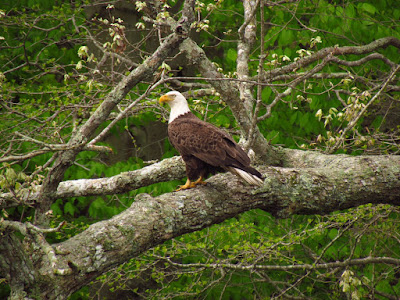A Great Egret stands guard at Pocket Knife Corner. An Osprey is flying overhead. I'm watching a Great Blue Heron sail through along the treeline. There's a loud ker-plunk in the river not 20 yards ahead and my eyes shift to see the Osprey climbing up out of the water with a small fish in talon. A Yellow Legs is striding past the Great Egret guarding Pocket Knife Corner.
Within the next half mile I have cruised over a 15 inch and an 18 inch snapping turtle. Two Canada Geese are herding six very fuzzy yellow newly hatched goslings, keeping them up near the steep bank where there are root balls to hide under should any predator approach. These are the first goslings of the year.
These are just the highlights. Onward.
I pass under the Stone Arch Bridge and enter the upper marsh well down in the banks, the sky large but the view truncated. I keep my eyes out for coatamundi, bandicoots, and indigenous peoples who might be warily spying on my passage. Although I know that the indigenous peoples that can afford to have a view of the river cannot afford to not be at work. You only see their landscapers.
 |
| Goose nest |
Just above the Railroad Bridge I watch the mating dance, and the mating, of a pair of Willets. I've seen this once before, a few years ago. The male chirps continually while quivering his wings in display before mounting the female.
 |
| Mating Willets |
I go all the way to the mouth to check for other birds that sometimes are present on the sand beach at the last turn. I've seen Oyster Catchers and Ruddy Turnstones before, but today there is nothing but a few Willets.
I spot one mature and one immature Bald Eagle near the Duck Hole Farms. And I cruise over two large snapping turtles before ending where I started from.



























